| Columns Retired Columns & Blogs |
I love the REI sourced shroud.
What a day...I wanna hear these and the new giant Wilson.
That would be a cool shoot out.
The BeoLab 90 is so massive that, rather than having it shipped to my home, I traveled to Kal Rubinson's place to take some measurements. I used SMUGSoftware's Fuzzmeasure 3 app running on my MacBook Pro, along with an Earthworks QTC-40 microphone and a FireWire-connected Metric Halo ULN-2, which combines a low-noise microphone preamplifier with A/D and D/A converters. (These were set to a sample rate of 96kHz for the measurements and I fed Fuzzmeasure's analog signal to the Master loudspeaker where it was converted at 192kHz.)
First of all, as KR described in his review, the BeoLab 90 system uses digital signal processing (DSP) to correct the room's acoustic. However, it differs from conventional correction solutions in applying not just individual filters for the Left and Right speakers, but also filters to correct the speakers' summed (Mono) output and the difference between their outputs (Side). The responses of these filters, as set up by B&O's Geoff Martin, are shown in fig.1 (Mono and Side) and fig.2 (Left and Right). Both sets of filters are applied simultaneously; you can see that the amount of correction is relatively small, covering a range of +5 to –6dB.
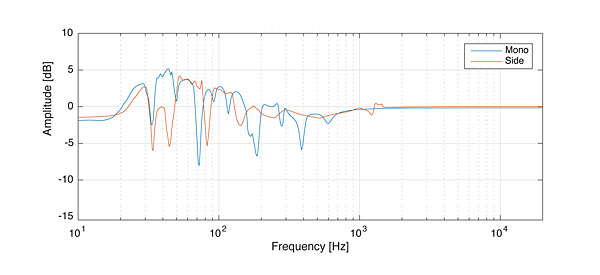
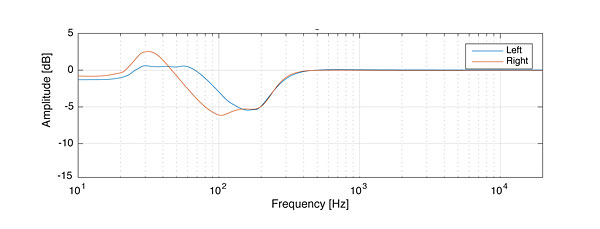
Also, as KR noted, no correction is applied above 1kHz. Yet, as seen in fig.3, which shows the corrected responses at the listening position of the two speakers in Narrow mode, their outputs above 400Hz are even, and above 1.5kHz are extraordinarily flat. While this might be thought to be a good thing, with an in-room measurement, the target response should gently slope down in the top octaves. Depending on the room's size and furnishings, a speaker that measures flat at the listening position will sound a little bright, as KR found in his auditioning, though I note that he did describe the sound as having a "mere suggestion of brightness in the very high treble."
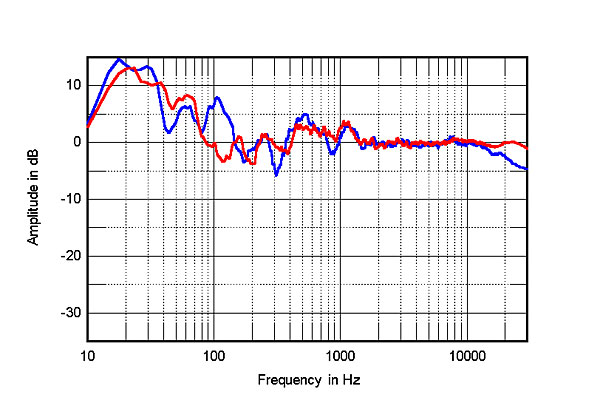
There are still some room effects visible—the lack of lower-midrange energy and the peak at 105Hz in the left channel—but these are mild, especially when you consider that there was no spatial averaging in this graph. I suspect that the increase in level in the low bass arises from the usual boundary reinforcement in this region—KR had each speaker situated just 18" from its respective sidewall. Though this rise looks alarming (footnote 1), it was not as audible as you might think—other than in the magnificence it added to the organ recording of mine mentioned by KR, which has significant energy below 32Hz. The sensitivity of human hearing decreases rapidly at low frequencies, and low-frequency sounds must be played at a much higher sound-pressure level to be perceived as being as loud as mid-frequency sounds (footnote 2).
For fig.4, I measured the BeoLab 90's spatially averaged response in each of its three modes of operation. (I average 20 1/6-octave–smoothed spectra, individually taken for the left and right speakers in a rectangular grid 36" wide by 18" high and centered on the positions of the listener's ears. This mostly eliminates the room acoustic's effects.) The red trace was taken in Narrow mode; despite the additional measurements that contribute to the averaging, it is very similar to the responses shown in fig.3. The blue trace, taken in Wide mode, is very similar to the Narrow-mode response in the middle and low frequencies, but there is less treble energy at the listening position, presumably because more energy is being directed to the speakers' sides and being absorbed by the room's furnishings. Finally, the green trace was taken in Omni mode—the spatially averaged response centered at the listening position is tilted up below 400Hz and down above 5kHz because the speaker is now radiating equally in all directions.
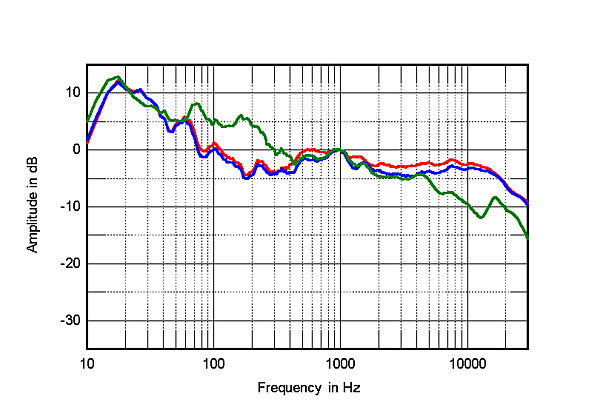
Finally, fig.5 shows the BeoLab 90's step response in Narrow mode. This was taken at the listening position, and so is disturbed by the presence of early boundary reflections—which also meant that I wasn't able to calculate the usual cumulative spectral-decay plot from the impulse-response data. However, you can see that all of the speaker's drive-units are connected in positive acoustic polarity, and that each unit's step blends smoothly with that of the next lower in frequency, suggesting an optimal crossover topology. Note, too, that the 0 milliseconds mark in this graph's time scale is arbitrary, dictated by the limitations of the program I wrote to translate Fuzzmeasure's time-domain data into data compatible with DRA Labs' MLSSA, which I used to calculate the step response. The BeoLab 90's DSP actually takes around 30ms to apply its corrections to the digital signals, meaning that the sound from the speaker reached the microphone 33ms after the stimulus signal was sent to the loudspeaker. When I discussed this latency with Geoff Martin during his visit to KR's room to set the speakers up, he explained that the goal was to keep this time equal to or less than one video frame— ie, 1/30 second.
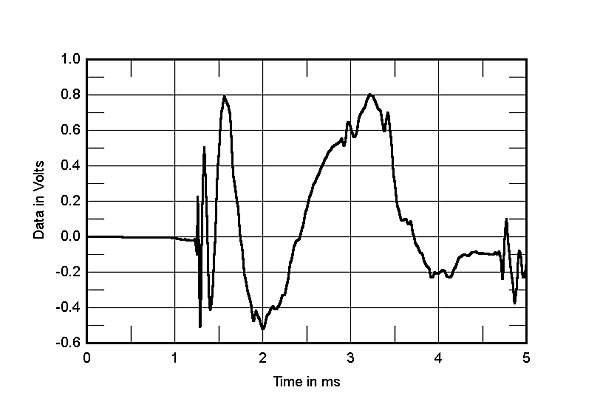
To say I was impressed with how the BeoLab 90 measured in its Narrow mode would be an understatement. This loudspeaker demonstrates just how much can be achieved with intelligent use of DSP to optimize its acoustic performance. As Kal Rubinson summed up, it is a tour de force. Wow!—John Atkinson
Footnote 2: See fig.2 here.

I love the REI sourced shroud.
What a day...I wanna hear these and the new giant Wilson.
That would be a cool shoot out.

Funny, my first thought was North Face tents caught in the wind.

This was new to me. From the descriptions in this article, all previous designs to control phase/response/timing etc. are woefully primitive by comparison. Given this technology and the inclusion of the amplification, the price seems reasonable. Some people worry that they would spend a lot of money on a product that drops drastically in price soon afterward, when they can't get a refund or adjustment credit. On that note, if this design were to catch on and "go viral" so to speak, there would have to be a few unhappy folks who bought the "other brand" for even more money than the 90.

Conceptually sounds similar to the Kii Three, which is smaller and much cheaper(about $15k all in).
Would be interesting to compare the two, or to the larger floor standers coming from Kii.

The main emphasis with the Kii is the use of DSP to create a cardioid bass pattern so you get less room interaction in the bass. Other than that, it's a fairly standard design that uses a dsp crossover.
The B & O is far more advanced in that it provides directivity control over the entire operating frequency range and allows a tremendous amount of versatility. It also has insane amounts of power behind it and large amounts of radiating area. Dynamics are incredible.And while the Kii sounds "ok" the B & O simply blows your socks off. It's easily in the top 5 of the best speakers I've ever heard, and blows away any passive system I know of. B & O may have had a reputation for just being a "pretty face", but the Beolab 90 is something altogether different and IMO really points the way to how loudspeakers truly advance. It's about time. The loudspeaker industry has been basically "churning" for many years now with very little advancement.

Wasn't trying to say the Kii is the equal. Was saying it is a similar concept for about 1/6 of the price. It might be a better solution in a small room.
Calling it a "fairly standard" design is incredibly dismissive: how many standmount speakers do you know of that are full frequency range, contain 6 drivers, amps, and DACs, all controlled by DSP to enable time domain accuracy and limited interaction with side and front walls?
Start naming your list of all those "standard" speakers....I'm waiting.
Your dismissive comment about the Kii as being only "okay" is also sort of amusing, as so far both personal and professional reviewers have called it one of the best (note, not "the best") systems they've heard, equal to many at several times it's price. The apparent fact that it isn't as good as an $84000 system doesn't take away from it's accomplishments or the fact that it is revolutionary in its on right. And based on size and price, will probably end up in many more homes that the B&O 90. Nothing against the B&O, that's just reality.

I've heard the Kii Threes, and they are absolutely astounding. All the things said in this review about presentation of recorded space etc. are true of them, more so than any other loudspeaker I've heard, and in a ridiculously small and efficient package (no peripheral DACs, amps, and the rest of the much-loved audiophile paraphernalia). I am going to arrange a demo of the BL90s shortly, if only to attempt to justify the Kii price ticket vs. the BL90s!

I imagine every "true" audiophile will "automatically" remove those Geodesic Dome Grill cloths.
The reviewer says they're "Handsome", I wonder if he's just being polite. B&O say's the 90s are beautiful in appearance.
In context, is this the most POWERFUL speaker system anyone has ever heard of? ( I once saw a speaker system with 3 sets of 200w Mono Amps and 1,000 Watts of Subwoofer = 2,200 Watts, I thought it was thunderous ( Krell Amps ), enough for a 7,200 cu.ft. listening room. These B&Os have four times the power ( each or the pair? )
The people that buy these will probably have 5.1, can these be configured for the Video Theater Room?
It's a nice Plus that they sound pretty darn good and saved their owner the extra $600,000 in cost of getting those new Wilsons ( not to mention all the additional electronics needed -- probably another 3 or 4 hundred thousand American ).
Looks like the Ultra-wealthy have as many difficult choices as we the unwashed masses.
Tony in Michigan
ps. do they offer an optional Cat protector?

Great write-up, and long overdue for a proper review of the Beolab 90. I'm looking forward to a full production unit being tested with all bells, and whistles up, and running.

I'm looking forward to a full production unit being tested with all bells, and whistles up, and running.
Our review was of a full production sample of the Beolab 90. Its control firmware was an early version.
John Atkinson
Editor, Stereophile

Yes. This unit was identical to what was being sold/installed to consumers at the time of the review and which we determined had all the features necessary to evaluate performance.

While broad downward tilt 200-20k is a euphonious idea with almost any speaker, it is also highly dependent not just on room size and furnishings but also on horizontal radiation pattern. An extremely upper-mid- and treble-dispersive design like this one wants considerably less of it than other designs. Every Allison owner knows this (also perhaps Ohm, Shahinian, DA, BL5, and other owners), and this fact was pointed out by Julian Hirsch in the many reviews he wrote of dbx Soundfield designs, an earlier beamforming phased array (e.g. see www.hifi-classic.net/review/dbx-soundfield-100-135.html).
Second, it is completely fascinating that the BL90 SP programs may not be perfected yet for lower-midrange balances and 'unrippling', i.e. the crucial half-octave above and the octave-plus below middle C. That is where boundary augmentation effects begin being *fractional* but are not yet summing coherently, of course. It is a problematic, dynamic area for most designs, work-aroundable only with some serious savvy. It will be interesting to see if BL90 future rev is able to improve supple handling of the two 90-360Hz octaves. Unless it was anomalistic in the setting.

This is one of the best comments I have ever seen in a hi-fi mag. May I offer what I think should be a minor correction? "...upper-mid- and treble-dispersive..." I think should have read something like, '...upper-mid- and treble-dispersion-limited (or directivity-controlled, if you prefer pro audio parlance).'
The only approach I have ever found that resolves the low mid problem that you so correctly describe with old-school technology is a large midbass horn - hardly practical for the average audiophile, unfortunately. The DSpeaker Anti-mode 2.0 does an admirable job, and I see no reason why the B&O engineers could not address the problem in a similar fashion. It would indeed be interesting to see if a later firmware load adds this capability.

That is a very kind thing to say, but your first para indicates you did not understand what I wrote. Highly dispersive designs are exactly the opposite of directivity-controlled. It is with the former (and sometimes w/ planars) that a serious downward tilt is most euphonious on much program, to reduce the relative level of treble, though not its distribution in the reverberant field. Beamy speakers, even in the new style of constant beaminess or at least uniformity (no stitches audible), if you tilt down their output, typically do not benefit at all; listeners say there are not enough highs.
There are ways to overcome the Allison effect, as it is a near-corner-positional problem, a function of the distances, similar or hopefully dissimilar, meaning staggered, from the woofer to the three near boundaries. It does not require a horn or even a separate lower-mid driver. You can locate the woofer right near a boundary (or two, or three) but have it cover well up above middle C, like to 300-400Hz. Or you can suggest / enforce that its distances from floor, front wall, and sidewall are staggered 2/3/4 or 2/3/5'. Or, finally, since it is to first order independent of listener position (it is NOT related to room resonances), you can EQ it out with a canny bump to compensate for the inevitable lower-mid dip.
Fwiw, JAtkinson is one of the very few reviewers to understand this problem well, and show it frankly in his room measurements.

If you are willing to come out of retirement to afford a pair of these, give the Spatial Audio X1s (http://www.spatialaudio.us/x1-main) a review for comparison. A hunch - and a more elegant design philosophy and benign price tag - tells me the X1s could surprise you for a 7 times smaller investment, and keep you at home enjoying your well earned retirement.
I'd personally hook them up to a pair of Benchmark AHB2s and a DEQX HDP5, but that's just me; I'm sure Vinnie Rossi's LIOs can do the trick for you, if you want have to go all in with the lifestyle kitsch of esoteric boutique components.
I would very much like to see the Spatial Audio X1s reviewed and measured up against the megabuck flagships and emblems of the box-speaker paradigm.
The reference to the Kii Threes in the comments certainly belongs in a more elaborate discussion surrounding the Beolabs and the design concept - and assumptions - behind them. But so do the Grimm Audio LS1bes and a bunch of other speaker whose design have drawn and capitalized on the trajectory and explorations of Herr Linkwitz.
It would be great to see more in-depth tech talk such as your succint introduction to the assumptions behind the Beolabs design, and how B&O and other manufacturers similarly frame the problems to be tackled by engineering solutions in speaker design... and less hype buzzing around mega expensive luxury objects.
I totally agree with your reference to L'Arpeggiata & Christina Pluhar's recording with the fabulous alpha label, their amazing musicianship - and the recording quality - have provided a truckload of musical pleasure for years.
Happy New Year!

Hah! It wasn't until I reached the antepenultimate paragraph that I was certain you were addressing me.
The Spatial Audio X1s look interesting. I hope I can get an ear on them soon.

I could not find anywhere the speaker's sensitivity 1w/1m?
Same remark regarding not lifting the covers... especially when in the end $80,000 + buys you about $3,000 of Scan-Speak hardware per speaker... and that those are rated 89dB/w/m at best

I think you're rather missing the point here - these are ACTIVE, DSP-controlled speakers with digital signal inputs i.e. contain many 1000s of watts of amplification and signal processing. Sensitivity is only relevant when considering passive speakers that take amplifier signals and convert those directly to sound waves, and it represents the efficiency of that transducing function.
In respect of value for money, it's worth reading the series of blog entries on their creation - http://www.tonmeister.ca/wordpress/2015/10/06/beolab-90-behind-the-scenes/. You might see that they are lot more than $3,000 worth of randomly clustered ScanSpeak drivers!

Interesting. Controlled directivity has been an obsession of a certain section of the DIY community for a while now. As mentioned in some of the comments, Siegfried Linkwitz and his Orions and the the LX521 have aimed at providing this from bottom up through the use of dipole radiation.
I had Orions for many years. They were wonderful.
I also used DSP for crossovers and EQ. The sophisticated (at the time) possibilities helped, but you were still at the mercy of the room.
It's why headphones sound so much better in most ways than speakers.
The other issue with passive controlled directivity is that you are locked into a fairly narrow sweetspot.
As a couch flopper, this became annoying. I somewhat solved it by using coax drivers so I get the same sound almost everywhere, but the room is still the biggest influence.
Given the Beolab targets certain frequencies to cancel, I assume those frequencies are quite position-dependent. Certainly small movements of a mic can have major FR and phase differences. Was there a small sweetspot.
I'd also be very curious what B&O can do with a simpler system.
To a degree they are using acoustic cancellation (directed by DSP), but theoretically it is possible to manipulate phase and frequency entirely digitally. This is kind of what DEQX and Dirac promise, but don't quite deliver.
Finally, I have to tip my hat to B&O. They ar isgnore by most audiophiles, but crate some extremely clever products.
I bought my partner on of their tiny BeoPlay A1 speakers for Xmas and the sound quality is amazing for the size.

I heard this speaker in Copenhagen at the B&O shop and it was truely a big experience. They are the best box speaker I have ever heard, that was not a horn speaker.
Although they have some of the same qualities, as for example narrow dispertion, due to the DSP multi driver funktion. They also have great dynamics and are very transparent and accurate.
My guess is, that the big so called high end brands are sleeping restless, thinking of the monster, B&O has brought to the battlefield.

Some days ago I had such a fantastic experience at one of my friends home. His system was quite simple: Pink Faun 2.16X Server and a pair of Beolab90 speakers. Cable used by him at that time was relativelly unexpensive (in the meantime he upgraded power cables).
Over more than 25 years that I have been exposed to Hi-Fi and Hi-End systems I never heard such a magnificent system playing. I was not prepared for such a great experience... every new track from classic to rock played in an outstanding way. Believe me, I was jaw dropped at every new music.
In one word: SENSATIONAL !
Well done B&O engineers!